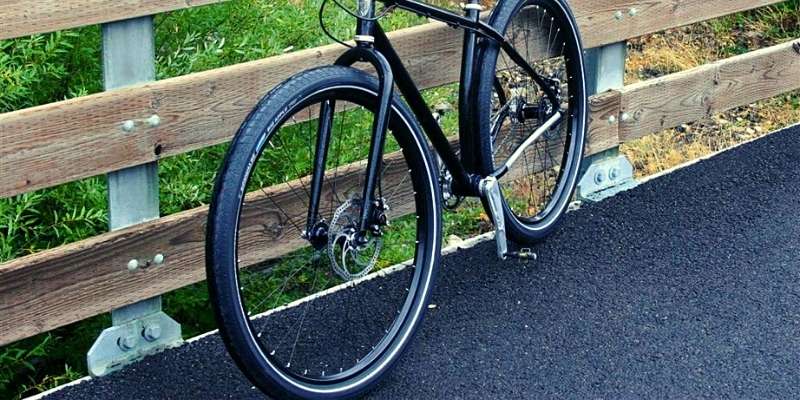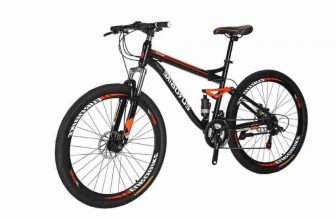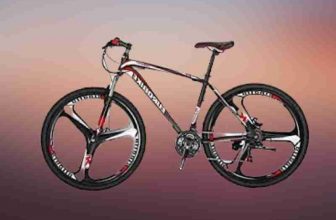
You might be surprised by what you can accomplish, but this is a unique and cool concept!
When you have a mountain bike with fat-tire rims and tires, you can go almost anywhere on any terrain, and the bike will still function as it usually would.
Moreover, mountain bike tires are typically designed to provide better traction and handling on unpaved surfaces, such as trails and gravel roads. While it is possible to replace road tires on MBT tires, the bike may not perform well on rough terrain.
Additionally, the tires may wear down more quickly when used on pavement. But it can work better for road riding.
Riding your mountain bike on the street may seem strange to many cyclists, but it is pretty standard. MTBs are less expensive than road bikes and offer a more stable but safer ride.
As a result, you can convert your MTB to street travel if that is your only mode of transport. However, it’s good to adjust the bicycle before replacing tires to make it more comfortable.
So, you can put the road tires. However, due to the fundamental difference in design between a mountain bike and a road bike, you’ll need to make additional adjustments and consider the bike’s design to make this transition work.
Things To Consider Before Putting Road Bike Tyres On A Mountain Bike

The Suspension
MTBs are built to withstand impact from rough terrain, and the majority come equipped with suspension for trail cycling. When riding on the street, the suspension is unnecessary, and if it does have a lockout, a simple adjustment is required.
If you don’t have a lockout on hand, you should now increase the air pressure in the suspension to stiffen it. This assists in minimizing bobbing while pedaling, standing, sprinting, or climbing. However, if you want a permanent change or need a seasonal change, a rigid fork will stiffen and lighten the bicycle on the street.
So, the tire pressure depends on the weight of the bike, the type of terrain, and the ambient temperature.
The Wheels
The simplest way to convert your MTB is to inflate the tires to 50-PSI. Before inflating, check the tire’s maximum PSI rating on the sidewall. When standing, you will notice the rolling resistance is more significant and more rapid.
Now is there a way to expedite the tire setup process? Many mountain bikers bring slick tires on long trips for street training. You can install the tires on a spare set of wheels or the MTB rim.
To fit the wheels, a 1.5-inch slick tire is recommended. Finding slick tires that work with the 29er size is not difficult these days. Alternatively, you can purchase a second set of wheels to minimize the time spent changing the tire. However, be sure to update your kit with the proper tube and tools for the tire size.
The Gearing
With a different set of MTB wheels, you can use a different rear gear set to help with gearing. Road bikes typically have more gears to allow for a more satisfactory cadence adjustment in close range.
On the other hand, the MTB is the polar opposite, as it allows for slower average speeds and steep climbs. As a result, when on the street, you want to spin quickly once you reach your road speed.
Additionally, many MTBs feature a single chainring that can be swapped out for a larger one even when using a different crankset.
Position Changes
Before swapping tires, consider making a minor adjustment by lowering the handlebars if you ride on the street and do not frequently switch between road and mountain setups.
The road rider’s handlebars are lowered to improve aerodynamics, whereas the MTB handlebars are raised. You can lower the steer tube, and it only takes a few seconds to complete the task.
However, your body will need time to adjust to the new position, resulting in hand pressure. If this is the case, replace it with drop handlebars similar to those found on a road bike.
Therefore, the things you might do to make your MTB comfortable for road and off-road traveling.
The Tire Sizes That Will Work Well For MTB
Yes, narrower tires can be installed, but this is dependent on the purpose of your MTB. Three tire diameters are available: 26 inches, 27.5 inches, and 29 inches. The tire width typically ranges from 1.6-inches to 2.5-inches, but it can be more significant.
While wider tires provide more comfort, balance, and grip, narrow tires allow you to unleash your cycling skills on rough terrain. The tire provides exceptional performance and reduces contact with increased acceleration on the road.
Additionally, it aids in weight loss by improving balance and control. The critical point is to select the proper tire size. It helps here if you consider the ISO-sized tire. According to the International Standards Organization, there are five sizes, and you should make tire/rim sizing into account.
While shopping for a narrow bike tire, keep an eye out for the ISO sizing description on the sidewall. The first number is the tire width (mm), and the second number is the tire diameter (mm). The most common size is 700C or ISO 622 and is compatible with the majority of MTB bikes, and is excellent for street riding.
However, the typical mountain bike size ranges between 2.0 and 2.4 inches and is ideal for trail cyclists and cross-country riders.
Can You Turn A Mountain Bike Into A Road Bike?
Conversion is as simple as inflating your mountain bike tires to 40–50 PSI. They’ll mount these tires on a spare set of wheels or their standard off-road wheels. If the pros prioritize this type of training and make it work on their mountain bikes, you can, too!
Is It Harder To Ride A Mountain Bike On The Road?
Mountain biking and road biking are two different sports. While they are similar, they are also distinct. One of the main differences is that mountain biking is typically done on trails with many obstacles, while road biking is done on paved roads.
This means that mountain biking requires more technical skills and strength, while road biking is more about endurance. Therefore, it is typically harder to ride a mountain bike on the road.
Will A Road Tire Make My MTB Go Faster?
Road bikes are bicycles that are specifically designed for paved roads. They have thinner tires than mountain or hybrid bikes, and they typically have a more aerodynamic frame to help them cut through the wind. Road bikes are popular among cyclists who enjoy riding long distances or participating in races.
Mountain bikes are bicycles that have been specifically designed for riding on mountain trails. They typically have thicker, knobbier tires than traditional road bikes and gearing that is better suited for climbing hills. Many mountain bikes also feature front and rear suspension systems to help absorb the impact of bumps and rocks on the trail.
Mountain bikes are popular among recreational riders and serious cyclists, who use them for mountain biking, cross-country racing, and downhill racing.
Rolling resistance is lower on mountain bikes because they weigh less. This makes them easier to pedal. So, each has its function and design.
What Size Road Tire Will Work On My MTB?
Tires come in three sizes: 26, 27. 5, and 29 inches. My bike is 29 inches with 2.3 inches wide.
So, one of the wide tires of the road bikes will work well for MTB because, usually, road bikes have narrower tires than a flat tire in mountain bikes.
How Much Difference Do Road Bike Tires Make On A Mountain Bike?
Mountain bikes are more comfortable and durable than road bikes. Road bikes are less comfortable and durable than mountain bikes. Replacing mountain bike tires with those used on road bikes reduces the comfort you get from riding on rough terrain. In extreme situations, the bike itself suffers faster degradation.
What Are The Best Road Tires For Mountain Bikes?
Some general tips that may be helpful include; choosing a tire with a lot of treads, especially in the center of the tire, to provide better traction when riding on rough terrain; and opting for a wider tire, which will provide more stability and grip when cornering.
In addition, on smooth roads. uneven surfaces and rough trails, the tire tread is necessary for the best ride
On the other hand, road bikes often have a little bit slick tires compared to mountain bikes, so the wide tires among the road bike tires will remain appropriate.
Moreover, the best tires of a mountain bike must bear a good brake grip for any terrain
Is There Any Bicycle That Has Mountain Bike Tires On The Back And Road Tires On The Front? If There Is What Do You Call That Bicycle?
Many cyclists switch out their tires depending on the terrain they are riding on. For example, mountain bike tires have more tread and are better suited for off-road trails, while road tires have less tread and are better suited for paved roads.
However, there is rarely such type of bikes.
What Is The Best Tire For A 29-Inch Mountain Bike?
The tire size depends on the specific needs and preferences of the rider. Some riders might prefer a more durable tire and can handle a wider range of terrain, while others might prefer a tire with a higher level of grip for more challenging terrain.
Finally, it is up to the rider to determine which tire is best for them; either slick or smooth tires will suffice.
However, 700c or 622 mm ISO (inside rim diameter) wheels can confer a comfortable ride.
How Big Of A Difference Are Road Tires To Mountain Bike Tires?
Mountain bike tires are more comprehensive and have more tread than road tires, making them better suited for off-road riding. They also have a thicker casing to protect them from sharp rocks and debris.
Indeed, the width of a road bike tire is less than the mountain bike. So, the Tire width is important because it affects handling and stability. A wider tire spreads the car’s weight over a larger area, which increases traction and stability.
The Narrow tires have a smaller diameter than wider tires that can patch with the ground, leading to increased rolling resistance and a decrease in fuel economy. Narrow tires are also more prone to punctures and sidewall damage.
Final Thoughts
Therefore, riding a mountain bike with road-smooth and narrow tires makes it possible. While many cyclists prefer a thin wheel, the choice is subjective.
Using a wider tire can increase the air volume and provide comfort while cycling on loose terrain. Simultaneously, narrow wheels provide an excellent cycling experience on hard surfaces, resulting in improved balance, weight reduction, and performance.
Thus, choosing the right tire depends on the terrain and above factors.






